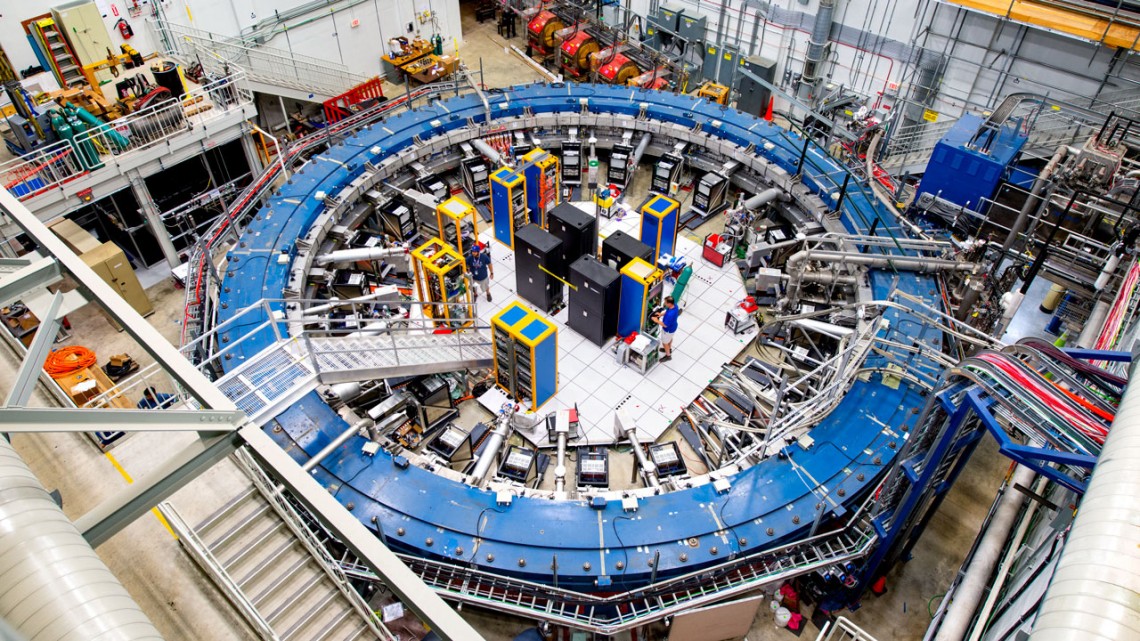
The muon g-2 ring sits in its detector hall amidst electronics racks, the muon beamline and other equipment at the U.S. Department of Energy’s Fermi National Accelerator Laboratory. This experiment studies the precession (or wobble) of muons as they travel through the magnetic field.
Latest muon measurement doubles precision
By David Nutt, Cornell Chronicle
For a tiny particle, the muon has a lot riding on it. And so do the scientists who are studying it.
Since 2018, an international collaboration hosted by the U.S. Department of Energy’s Fermi National Accelerator Laboratory has been measuring the absolute strength of the muon’s magnetic field. Their findings could open a whole new chapter in the story of particle physics.
A Cornell team, led by Lawrence Gibbons, professor of physics in the College of Arts and Sciences, has been playing a key role in the project by designing some of the technology that captures the muon data, and helping to radically improve the precision of the measurements.
That accuracy was demonstrated Aug. 10 when the collaboration, comprising 181 scientists from 33 institutions in seven countries, announced that it had doubled the precision of the muon measurement to 0.20 parts per million, confirming the findings of the first experiment run reported in 2021.
“We’ve hit a new precision frontier, basically. We know a factor of two better where nature says the anomalous magnetic moment sits,” Gibbons said. “And so now things have to get sorted out on the theory side.”
The Muon g-2 Collaboration is rooted in a historic 1998 experiment that stunned the physics world by indicating that muons’ magnetic field deviates significantly from the Standard Model, which is used to explain the laws that govern fundamental particles.
If the Standard Model is incomplete, there must be some kind of fundamental particle or force in the universe that has yet to be accounted for.
“That’s the Holy Grail, at some level, of particle physics these days, to really ascertain terrestrially what’s beyond the particles and forces that we know about,” Gibbons said. “We know there’s something else out there, because clearly there’s dark matter, but we’ve never been able to observe anything beyond the standard set of quarks and leptons that we’ve known about for a long time.”
Muons are similar to electrons but are more than 200 times more massive. While both particles have their own magnetic field, muons are far more unstable and decay in a few millionths of a second. They are also notoriously difficult to observe at the quantum mechanical level because the vacuum in which they exist is actually a bubbling, frothing environment, with virtual particles constantly winking in and out of existence, which affects the strength of the muon’s magnetic field.
Cornell helped sift through that froth by building the digitizers that look at the electronic signal coming out of the facility’s detectors – which seek to pinpoint the muon’s precession rate (i.e., the frequency of its rotational wobble) as it speeds around a 14-meter-diameter magnetic ring – and create a digitized version of the waveform that could be analyzed offline.
The group also built one of the two reconstruction packages that helped their collaborators parse and analyze the collected data.
The second run of the experiment, conducted from 2019 to 2020, produced about four times the amount of data from the first year with significantly improved quality, thanks to improvements to the hardware, such as insulating the superconducting magnet and stabilizing the temperature in the hall, and fine-tuning the analysis techniques.
Two members of the Cornell team, doctoral student Tyler Barrett and postdoctoral researcher David Tarazona, helped correct for subtle biases in the precession rate measurement that had been introduced when some high-voltage resistors in the electrostatic quadrupoles, which create the electric field, had partially failed during the data collection.
“There was also a correlation in the data that had plagued us before,” Gibbons said. “And they did a lot of fundamental work in terms of understanding the math behind exactly how we were extracting it, so we knew what the correlations were doing to us. And they played a key role in bringing the uncertainty of that correction down, as well.”
Once again, the Cornell team was one of seven groups that independently analyzed the precession rate result. The team had introduced a number of techniques during the analysis of the first experiment run that other groups have since adopted, such as how to correct for “pile up” – when the positrons that result from muon decay end up in the same place in the detector and confuse the algorithm that attempts to reconstruct them.
“Going forward, we’re bringing in new ideas on top of that, as well, that we’ll be able to incorporate for the remaining three years of data that should, in the end, give us another doubling of our precision,” Gibbons said. “Basically, that is another halving of the uncertainties in the long run.”
The final data collection wrapped on July 9, and analysis will continue for the next two years. Gibbons and Simon Corrodi of Argonne National Laboratory will serve as co-analysis coordinators for the final results of the project, to be released in 2025.
While the unblinding of the independent analysis has proven nerve-racking for all the collaborators, Gibbons said overseeing the final reveal of the magnetic field measurement will bring additional stress.
“We have larger ulcers,” he said.
Media Contact
Get Cornell news delivered right to your inbox.
Subscribe
